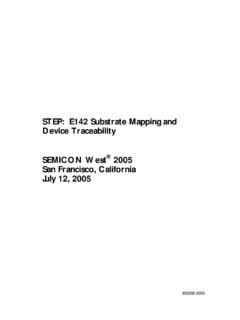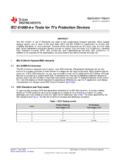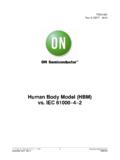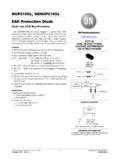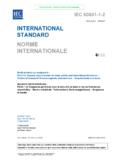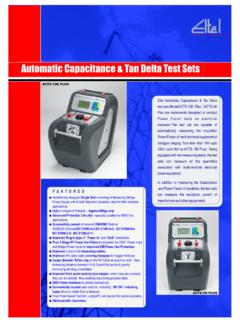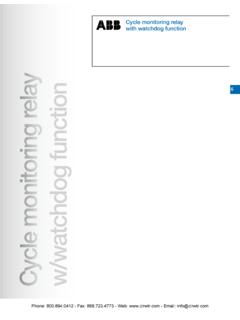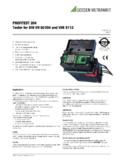Transcription of Overview of SEMI F47-0706
1 1 SEMICON Japan 2006 Overview ofSEMI F47-0706 Chuck ThomasSenior EngineerSemiconductor & Industrial PQ ServicesEPRI 942 Corridor Park BlvdKnoxville, TN 37932W:+ : Japan 2006 Why Change semi F47? The original semi F47-0200 (voltage sag immunity) was found to be highly successful in reducing service costs and increasing tool reliability and uptime. Since 2000, Semiconductor Manufacturers, Tool Suppliers and Compliance Testing Companies have amassed a significant technical and practical knowledge base related to testing. This information is beneficial to incorporate in the revised standard. Where Practical, more closely harmonize with new Standards such as IEC 61000 -4-11 and IEC Japan 2006 What Changed?
2 Removal of 50ms, 50% Vnom Test Point. Referencing of Test Durations are now presented only in Cycles with specific values for 50 and 60 Hz. Equipment must now pass at the test point levels rather than above the defined line Compliance with the new semi F47-0706 is defined by passing three test points rather than compliance to a Curve as defined in semi F47-0200. (Use of Implied Curve is still valid for comparing against PQ Data)4 SEMICON Japan 2006 What Changed? Test Vectors are Defined Original semi F47-0200 left this information implied. Single-Phase Test Vectors are the Same Three Methods of Allowable Phase-to-Phase Test Vectors are allowed Pass/Fail Criteria is broken out now for Tooling Equipment and Subsystems Tools Still use Interrupt Criteria Subsystems Have Three Classes of Responses Specific Requirements of Certification Documents are Defined A Significant Related Information Section aids the reader in a more in-depth understanding of intent 5 SEMICON Japan 2006 What Changed?
3 Addition of Section addressing how to use the specification for Procurement of tools, subsystems and components that are compliant to semi F47-0706 . Standard Specifically states that three-phase sags not Japan 2006 What Did Not Change? The Intent is the same to lead to tools that are robust to voltage sags through through component selection and design strategies. The Pass/Fail Criteria for Tools Did not Change (Based on Previous Interrupt Terminology) The basic test levels are the same (except for 50ms test point). Terminology is basically the Japan 2006 What Happened to semi F42-0600? semi F42-0600 has been superceded by semi F47-0706 and IEC 61000 -4-34 The semiconductor tool specific step-by-step approach for tool testing defined in semi F42-0600 has been replaced with a more generic test description.
4 Individuals who want an in-depth understanding of how to conduct voltage sag testing will need to contact industry experts for guidance. semi F42-0600 can still be used as a Japan 2006An Overview of the New semi F47-0706 including Supplemental Examples and Considerations9 SEMICON Japan Purpose10 SEMICON Japan Purpose Semiconductor factories require high levels of power quality due to the sensitivity of equipment and process controls. Semiconductor processing equipment is especially vulnerable to voltage sags. This specification defines the voltage sag immunity required for semiconductor processing, metrology, and automated test equipment. This specification strikes a balance between voltage sag immunity and increased equipment Japan Scope12 SEMICON Japan Scope This specification sets minimum voltage sag immunity requirements for equipment used in the semiconductor industry.
5 Immunity is specified in terms of voltage sag depth (in percent of nominal voltage remaining during the sag) and voltage sag duration (in cycles or seconds). This specification also sets procurement requirements, test methods, pass/fail criteria, and test report Japan Scope Primary Focus The primary focus of this specification is semiconductor processing equipment including but not limited to the following types: Etch equipment (Dry & Wet) Film deposition equipment (CVD & PVD) Thermal equipment Surface prep and clean equipment Photolithography equipment (Scanner, Stepper & Tracks) Ion Implant equipment Metrology equipment Automated test equipment Chemical Mechanical Polishing/Planarization equipment14 SEMICON Japan Scope Secondary Focus The secondary focus of this specification is subsystems and components that are used in the construction of semiconductor processing equipment, including but not limited to.
6 Power supplies Radio frequency generators and matching networks Ultrasonic generators Computers and communication systems Robots and factory interfaces AC Contactor coils and AC relay coils Chillers and cryo pumps Pumps and blowers Adjustable speed drives 15 SEMICON Japan Scope Application BoundariesThis specification applies to semiconductor processing equipment to include the equipment mainframe and all subsystems whose electrical power is directly affected by the operation of the equipment's EMO (emergency off) system. 16 SEMICON Japan Scope - Grandfather ClauseEquipment, subsystems, and components that were tested or certified under the previous version of this specification, prior to the publication date of this specification, do not require re-testing or re-certification until hardware or software design changes that could affect voltage sag immunity are implemented.
7 17 SEMICON Japan Limitations (summary) Addresses voltage sags only. If necessary, the Information Technology Industry Council (ITIC) curve contained in IEEE 1100 and semi E51 can be used to specify additional requirements outside the scope of this specification. Wafer Quality Not Addressed. This specification does not address wafer quality variations that may be caused by voltage Factory and Utility Not Addressed. See semi F49-0200 - Guide for Semiconductor Factory Systems Voltage Sag Immunity and semi F50-0200 -Guide for Electric Utility Voltage Sag Performance for Semiconductor Factories S2 is for addressing design issues related to safety. hazards could result from voltage sags deeper and/or longer than those considered in this specification, provision should be made to negate or eliminate such hazards.
8 Conflicts between this specification and safety requirements (such as semi S2) that cannot be otherwise resolved shall be decided in favor of safety requirements. This specification does not pre-empt or override international, national, and local codes that may apply in different facility Japan Related Standards and semi Standards semi E51 Guide for Typical Facilities Services and Termination Matrix semi S2 Environmental, Health, and Safety Guideline for Semiconductor Manufacturing Equipment IEEE Standards IEEE 1100 IEEE Recommended Practice for Powering and Grounding Sensitive Electronic Equipment (IEEE Emerald Book) IEEE 1250 IEEE Guide for Service to Equipment Sensitive to Momentary Voltage Disturbances IEC Standards IEC 61000 -4-11 Testing and Measurement Techniques Voltage Dips, Short Interruptions and Voltage Variations Immunity Tests (for equipment rated at 16 amps per phase or less) IEC 61000 -4-34 Testing and Measurement Techniques Voltage Dips, Short Interruptions and Voltage Variations Immunity Tests for Equipment with Input Current more than 16 A per Phase.
9 19 SEMICON Japan Terminology assist a response to an unplanned stoppage that occurs during an equipment cycle in which all three of the following conditions apply: The stopped equipment cycle is resumed through external intervention ( by an operator or user), and There is no replacement of a part, other than specified consumables, and There is no further variation from specification of equipment operation failure any unplanned stoppage or variance from the specification of equipment operations other than assists interrupt any equipment assist or equipment failure voltage sag immunity the ability of equipment to withstand momentary electric power interruptions or sags [IEEE 1250 ride-through capability].
10 Voltage sag an rms reduction in the ac voltage, at the power frequency, for durations from a half cycle to a few seconds. [IEEE 1100] Note: The IEC terminology for this phenomenon is voltage dip 20 SEMICON Japan Use of Specification for Procurement ( ) Defines how to use standard to specify voltage sag requirements. ( ) Defines how orders for compliant semiconductor equipment should specify the requirement for certificates (per section ) or test reports (per section ) and requirementsrelated to self or third-party certification ( ) Defines how orders for compliant subsystems and components should be specified regarding the pass/fail criteria (see paragraph and R1-6), requirements for tests report, self or third-part Japan Requirements22 SEMICON Japan Requirements Required voltage sag immunity Semiconductor processing equipment, subsystems, and components are required to be immune to the voltage sag levels and durations set forth in Table 1.

